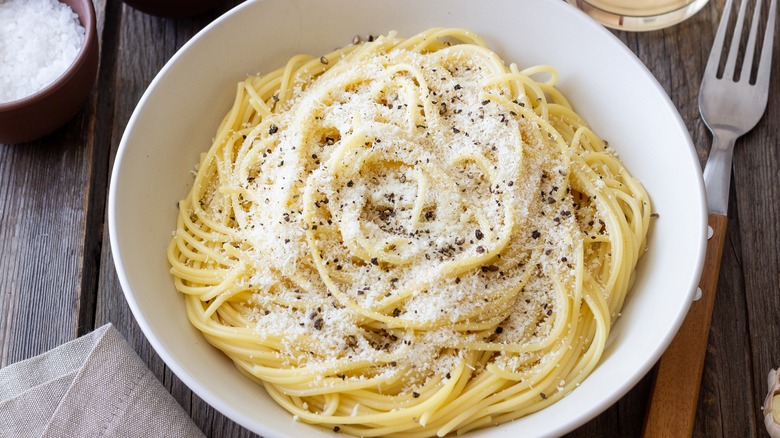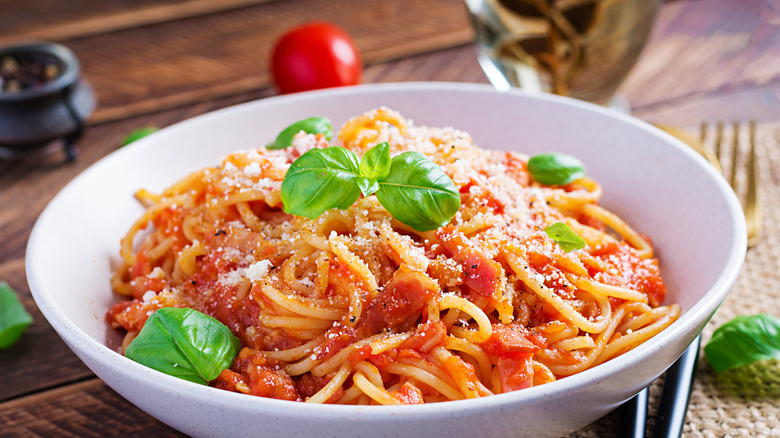Martha Stewart's 3-Ingredient Cacio E Pepe Is The Ideal Weeknight Dinner
When it comes to weeknight dinners, speed and simplicity are the name of the game — even for Martha Stewart. When she needs to whip up a quick dish, she turns to cacio e pepe, a classic Roman pasta. As she explains to Business Insider, it requires just noodles and three ingredients: black pepper, butter, and cheese. The dish is essentially made by mixing the three ingredients together with a good helping of leftover pasta water. When made correctly, you'll have a creamy sauce that coats each strand of pasta. To get the best results, however, Stewart has some important advice.
First off, you need the best ingredients. Stewart recommends starting with "really good pasta," pointing out spaghetti and bucatini as ideal options, or anything with a long shape that can soak up the sauce. Also, rather than adding the pepper right onto the noodles, you should start by blooming it in butter. Doing so will draw its flavor out. For the dairy component, Pecorino Romano — a tangy cheese made from sheep's milk that is similar to parmesan — is a classic ingredient for the perfect cacio e pepe. You can also mix in other Italian aged cheeses like Parmigiano Reggiano to round out the flavor, though it's not as authentic. Grate the cheese as finely as possible, preferably on a microplane, so you can more easily incorporate it into the sauce later.
Building the perfect sauce for cacio e pepe
In Martha Stewart's recipe, she explains that making excellent cacio e pepe comes down to melting the cheese into a luxurious sauce — and there are some key ways to do so. Adding the cheese to an overly hot pan will cause it to seize up and form unpleasant clumps rather than turning silky-smooth. Rather, the best way to avoid this is to turn off the heat and add the cheese last. Then you can shake the pan and vigorously stir everything until a creamy sauce is formed.
In addition to this classic technique, Stewart offers some tweaks on the tried-and-true cacio e pepe formula. For one, she recommends adding both lemon zest and juice for a fresh pop of acidity. She also uses Grana Padano cheese along with Pecorino Romano. This aged cheese offers similarly nutty notes to parmesan, but its softer texture lets it melt more quickly than Pecorino Romano.
The famed cook also recommends deliberately undercooking your pasta, a helpful technique that lets the noodles finish cooking once sauce is added: When you are two minutes shy of the package's cooking time directions, toss the noodles with the butter, pepper, and pasta water before killing the heat and adding the cheese.
Explore more Roman pasta dishes for quick weeknight meals
Cacio e pepe is one of four classic Roman pasta dishes, and they're all quick-cooking meals that make for great weeknight dinners. Aglio e olio is another simple one. All you have to do is cook garlic with plenty of olive oil, and then toss cooked noodles with pasta water and the flavored oil. Just as with cacio e pepe, this will form a rich emulsion. It also has the added benefit of being vegan (as long as you don't sprinkle on any cheese).
Next up is bucatini al'Amatriciana. This dish features guanciale, AKA cured pork jowl comparable to pancetta or bacon but with more warm spices. The sauce is made by crisping guanciale so that its ample fat renders out, then adding black pepper and a can of whole tomatoes (ideally crushed). Unlike a marinara sauce, you're not looking to cook this one for a long time; just about 15 minutes should be enough. As with the other dishes, finish it by tossing the noodles with the sauce, pasta water, and some cheese.
Finally, spaghetti alla carbonara can round out your adventures in simple Roman cooking. Where al'Amatriciana marries guanciale with tomatoes, carbonara combines eggs with pancetta. The eggs are added at the very end and carefully tossed with the noodles and crispy pancetta to form a creamy sauce. Just make sure you watch the heat so that eggs thicken but don't scramble.



